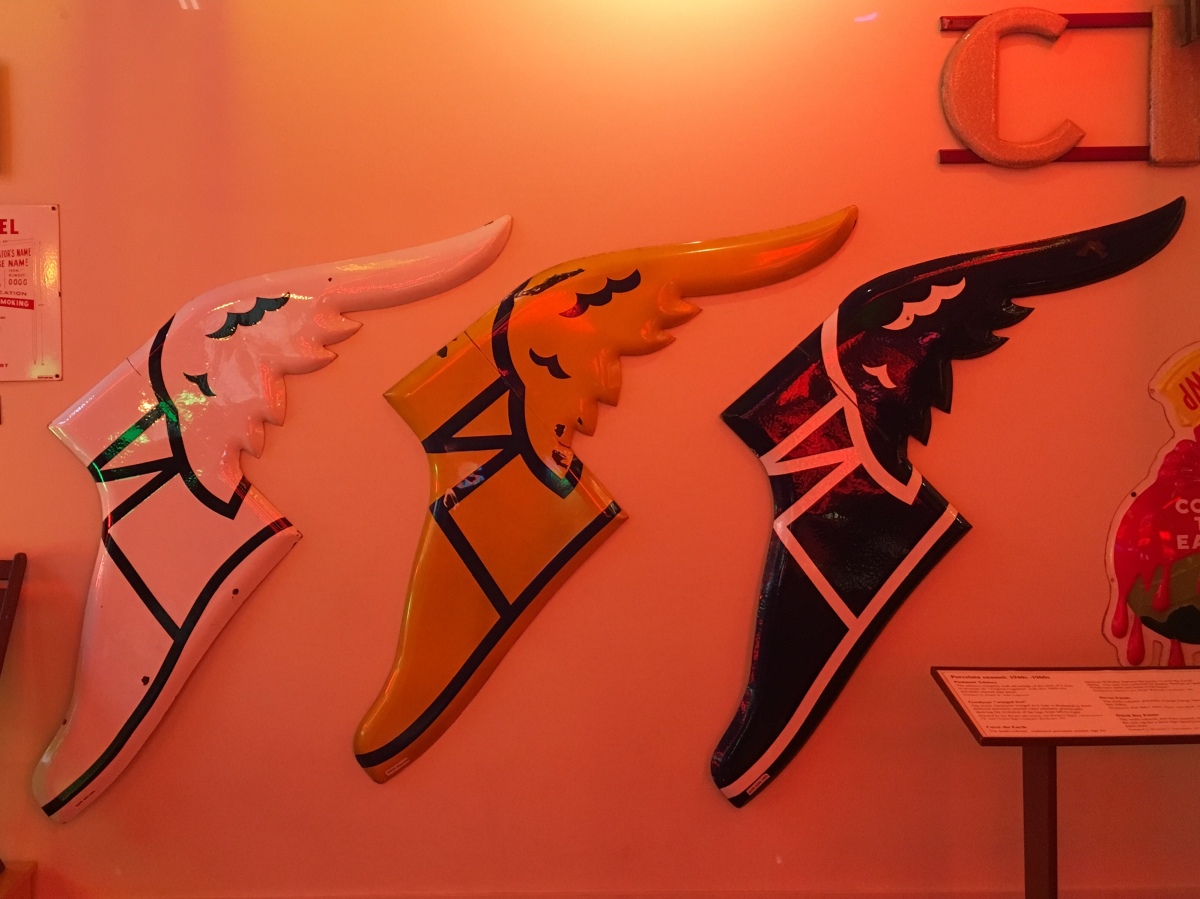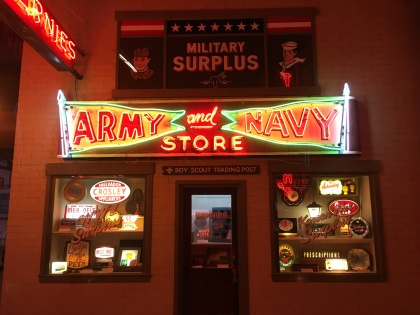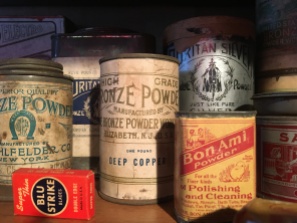Going to the American Sign Museum in Cincinnati, Ohio was like going back in time to my childhood and reliving road trips I’d enjoyed in the 1960s and 1970s. It took me on a tour of small town America and iconic hotels and food establishments. This was one of the most enjoyable places I visited in Cincinnati, a photographer’s delight.

Entrance to the American Sighn Museum

giant pig

baseball grounds & radio stations

Fashion Frocks

Building a Better Future

Holiday Inn

Signs of the Times & bowling pin
According to the museum, signs are the oldest form of advertising and have been documented in ancient Egyptian, Greek and Roman civilizations, as well as the Middle Ages. Signs have been symbolic throughout history and have taken shape as “trade signs.” These are visual images – painted, but more often three-dimensional — that represent the business, product, or service. A dentist might have a large tooth representing his office, a cobbler might have a large shoe.
The use of letters is a more recent development, mainly from the mid to late-19th century. At first letters were flat-painted onto a background, but the cut-out letter soon followed.
Hand-carved and gilded letters appeared in the 1890s, and moved to the first electric signs of the Lightbulb Era, represented by a lightbulb-studded changeable letter around 1910. From there, it progressed to the introduction of backlit, “raised” opal glass letters from the late teens. Next is the beginning of the Neon Era in the late 1920s, with exposed tubing mounted on raised letters.
Cut-out, cast and other forms of metal letters – including porcelain enamel beginning in the 1930s – proliferated throughout the 1900s. Plastics became more widely available after World War II. Plastic, as well as metal, continues to be a major force in letter design and fabrication today.

dimensional letters

dimensional letters
Early Painted Wood Signs 1900-1940
Showcards were a staple of commercial sign shops up until the advent of digital printing in the 1980s. They could be as simple as department store “Sale” signs or as refined as the theater posters of the 1920s – 1940s with portrait-like pictorials of starring actors and actresses.
The late 1960s version of the famous Big Boy icon has the tell-tale 3-D slingshot, red hair and striped pants of the early version. The modern Big Boy also sports checked pants vs. the early stripes, and brown or black hair instead of the more mischievous red. Today’s Big Boys are not as well-fed as the original.

Big Boy and Phillips 66
The double-faced porcelain enamel of Phillips 66 would have been mounted on a pole. The Dolly Madison Luncheonette signs is a mid-1930s art deco sign found in Irvington, NY. The ones shown is an economical non-illuminated version with slightly raised text.

Big Boy and Phillips 66
Goldleaf on glass was seen as the most revered technique among signpainter circles. Gilding was “high art” and commanded great respect, perhaps partly for the lure of gold itself.
These large glue-chipped and gilded mahogany-framed glass signs were originally created for a cigar store owned by the Breneiser family. The signs epitomize the height of fancy glass signs of the late 19th and early 20th centuries.

Chas. Breneiser, Breneiser
Pre-Neon or Lightbulb Era 1900-1930: The 1927 opal glass letter production sign for Bostonians Shoes was manufactured by Flexlume Sign Corp., Buffalo, NY.

Bostonians Shoes and Kelly Springfield Tires
Porcelain enamel: 1940s – 1960s
The iconic Goodyear winged foot logo is displayed in three different porcelain enamel color schemes, presumably showing the evolution of the logo from left-to-right.

Goodyear winged foot logo

Porcelain enamel color samples
Post-WWII Neon Era 1945-1960

Missoula Drug Co & Emmanuel Baptist Church
The early 1930s neon sign for Natural Bridge Shoes is noteworthy for its mitred corners and the black block-out glass incorporated into the “$5 ARCH SHOE $6” tubing.

Gasoline and Natural Bridge

Blume’s Apparel Shop

United Pentecostal Church

Emmanuel Baptist Church and Missoula Drug Co.
1950s-60s large-scale neon
Foster’s Freeze is of double-faced painted sheetmetal. The plastic ice cream “insert” in the cone is internally illuminated with a lightbulb. Cerveri Pharmacy is a double-faced neon sign showing remnants of its baked enamel finish. The 1950s sign identified a business in Reno, Nevada.

Foster’s Freeze and Cerveri Pharmacy
The early 1950s SkyVu Motel porcelain enamel neon sign originally identified a Kansas City area motel. It is a “transition sign” because it bridges the Neon and Plastic Eras evident in the plastic sun/moon and cloud formation, which are internally illuminated with neon.

Howard Johnson’s and SkyVu Motel

Howard Johnson’s

McDonald’s Hamburgers

Acapulco Mexican Food, Georgiton’s Pizza
The unrestored porcelain enamel icon Big Bear originally identified a Big Bear grocery store, headquartered in Columbus, Ohio.

Big Bear

Neon
Plastic: Post World War II – early 1970s
The mid-1950s internally illuminated Bus Depot sign originally identified a bus station in an unknown small town in Wisconsin.
An excellent example of a sign bridging the Neon and Plastic Eras by incorporating both types of illumination, the backlit plastic and exposed neon “Golfer,” identified a short nine-hole golf course at a former Rochester, NY amusement park. It was originally mounted on a pole and rotated.

Bus Depot and Golfer
The iconic Colonel Sanders Kentucky Fried Chicken sign was manufactured in the late 1950s.

Colonel Sanders Kentucky Fried Chicken

GULF, KONA LANES

Atlantic White Flash gas pumps
Sign-making tools of the trade included lettering enamels and paintbrushes, Speedball textbooks of lettering and poster design, wood graining compound, antique bronze & aluminum powders, varnishes, lettering colors, japan colors, reflective glass beads, glass buttons, etc.
*Saturday, March 2, 2019*
*********************
“PHOTOGRAPHY” INVITATION: I invite you to create a photography intention and then create a blog post for a place you have visited. Alternately, you can post a thematic post about a place, photos of whatever you discovered that set your heart afire. You can also do a thematic post of something you have found throughout all your travels: churches, doors, people reading, people hiking, mountains, patterns, all black & white, whatever!
In my case, my intention was to look for thematic possibilities during my trip to Cincinnati and I found the delightful American signs at the American Sign Museum to be quite delightful and nostalgic.
You probably have your own ideas about this, but in case you’d like some ideas, you can visit my page: photography inspiration.
I challenge you to post no more than 20-25 photos (I have a lot more here!) and to write less than 1,500 words about any travel-related photography intention you set for yourself. Include the link in the comments below by Wednesday, August 7 at 1:00 p.m. EST. When I write my post in response to this challenge on Thursday, August 8, I’ll include your links in that post.
This will be an ongoing invitation, every first, second, and third (& 5th, if there is one) Thursday of each month. Feel free to jump in at any time. 🙂
I hope you’ll join in our community. I look forward to reading your posts!
the ~ wander.essence ~ community
I invite you all to settle in and read a few posts from our wandering community. I promise, you’ll be inspired!
- Jo, of RestlessJo, embarked on a stunning hike filled with lakes, gorgeous light, and hydrangeas in the Azores.
Thanks to all of you who shared posts on the “photography” invitation. 🙂




















What a fantastic place! I didn’t know aout that at all. Well – next time. 😉
LikeLike
You would love it, Pit. It’s a bit off the beaten track. You would never just run into it, but I’d heard about it through a book I read about off-the-beaten-path places in Cincinnati. I highly recommend it if you can make it. 🙂
LikeLiked by 1 person
I’ll keep it in mind for when/if I’ll be back to “Porkopolis”.
LikeLike
I hope you enjoy if you make it back. 🙂
LikeLiked by 1 person
🙂
LikeLiked by 1 person
What a thrilling ride! I loved these images and the nostalgia!!!! Ml
LikeLike
Me too. I was delighted by this place. Between this and the Cincinnati ArtWorks program – which is responsible for many great murals throughout the city – I ended up loving Cincinnati. I’m going to stop back through on my way to the Dakotas in September. 🙂 They’re very nostalgic, aren’t they?
LikeLike
This would be so interesting to visit. The only ones familiar to me are the Holiday Inn, KFC and Goodyear. It’s interesting to see a different version of McDonalds too.
LikeLike
It was a delightful place to stop, Carol. You would love it. I loved all those old-fashioned signs that took me on a trip down memory lane. 🙂
LikeLiked by 1 person
What a great collection
LikeLike
Thanks, Albert. I loved it. 🙂
LikeLiked by 1 person
What a fascinating museum! I love that this sort of everyday stuff is being preserved and documented as well as “high culture”.
LikeLike
I almost enjoy this kind of thing more than I do “high culture.” I loved it. Thanks so much, Anabel. 🙂
LikeLiked by 1 person
Hi Cathy,
here is my short Hemingway-in-Austria blog regarding your photography invitation.
https://urbansimulator.wordpress.com/2019/08/06/hemingway-montafon/
Good night and best greetings now from Lower Bavaria, next stop in a few days somewhere in Bohemia 🙂
LikeLike
Thanks for this, Ulli. As you know from my comment on your post, I really enjoyed it. It’s linked to today’s photography post. 🙂
LikeLiked by 1 person